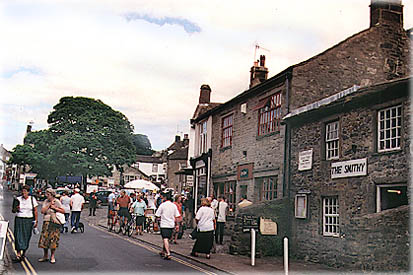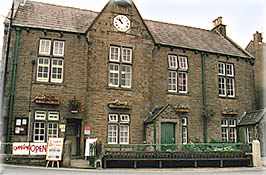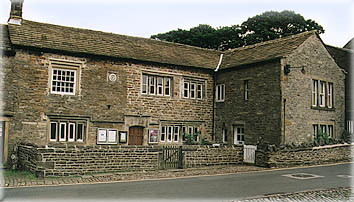GRASSINGTON

Grassington is the focus of Upper Wharfedale and the Limestone Dales. It has the character of a village but the function of a town. Of course today it is also a tourist centre but, so long as one avoids summer weekends and bank holidays, it is still pleasantly quiet and unspoilt. If the visitor stays for a while, by the third day one is recognised in the shops and pubs and the natives are warm and friendly.
Grassington
pre-dates the Conquest and was granted a charter in 1282 enabling it to hold a
weekly market and annual fair. In the nineteenth century its agricultural base
was supplemented by lead mining (since abandoned) and water-powered corn mills
though these too closed after the development of large-scale steam power
elsewhere.
|
The Church House |
It
is built round a cobbled market square, which of course isn’t square at all,
and which is fringed with a variety of buildings – the seventeenth century
Church House, eighteenth century Grassington House with tall sash windows, the
Black Horse coaching inn and the Devonshire Arms together with houses,
cottages and shops of different type and age. Oddly
Grassington has no Anglican church. It shares the beautiful twelfth century
church at Linton with Threshfield and Hebden. Linton is a delightful village
with groups of houses built informally around an irregular village green
through which flows Linton Beck. We worshipped at the church on Easter Sunday
some years ago on a sunny spring morning when daffodils in the churchyard
struggled in a bitterly cold wind. We were made to feel very welcome.
|
Nearby
are Grass Woods, an important nature reserve. There are invigorating walks to
be had on the fells around. One can explore further up Wharfedale – Coniston,
Kettlewell, Littondale, Coverdale, Buckden and where the dale changes its name
to Langstrothdale.
A
few key facts for visitors to Grassington. The Black Horse has reliable
no-nonsense good food, decent beer and clean unpretentious accommodation –
we’ve stayed there several times. The bar with its real log fire and
interesting local regulars is a great place to spend a late evening. There is
a good baker’s at the bottom of the square with excellent bread, custards,
apple pies, vanilla slices and treacle tarts among other things. Below the
square is an old-fashioned sweet shop where loose sweets are still weighed
out. Up the hill from the square is a cosy post office with local books and
hand-made cards and a pleasant atmosphere and no pressure to buy – though
you do.

The Town Hall
J B Priestley said: ‘In all my travels I’ve never seen a countryside to equal in beauty the Yorkshire Dales’.
An understatement, I’d have thought. DB
Old Kiln Limestone Outcrop Ramblers




